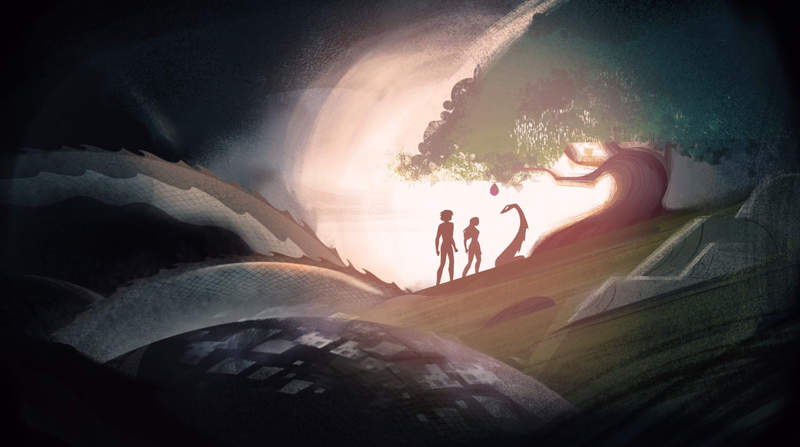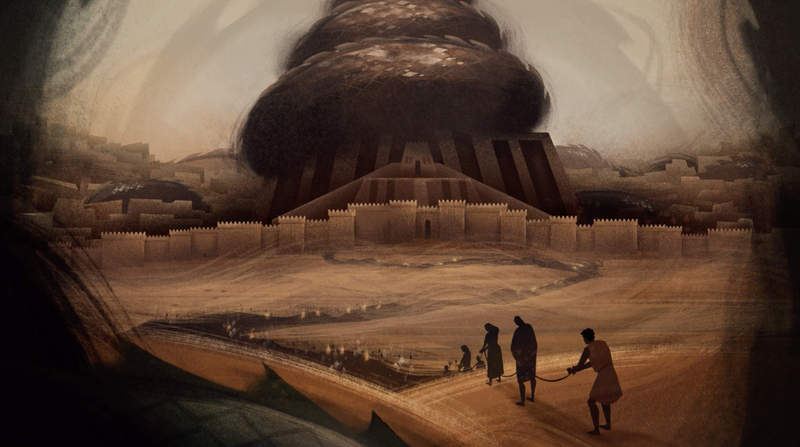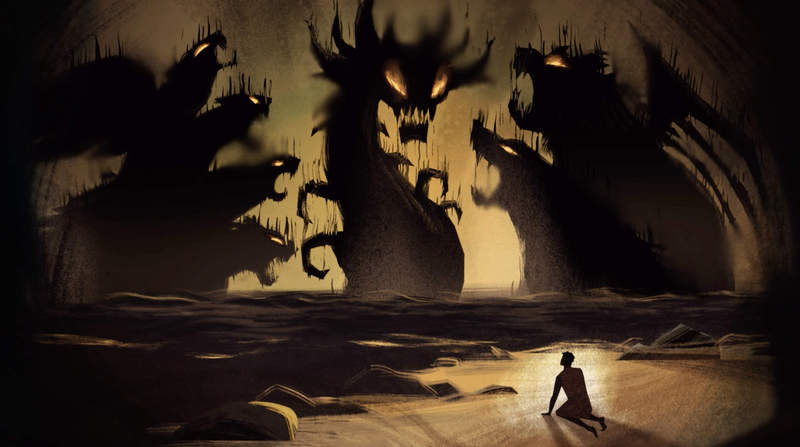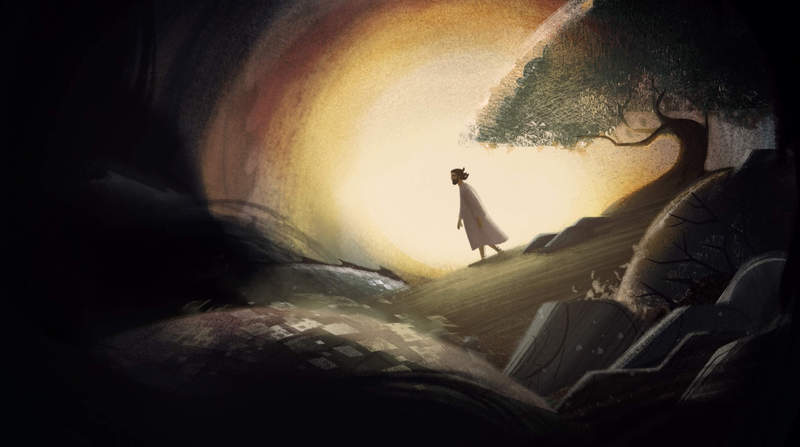Dragons in the Bible
About

Many ancient stories describe a dragon-like monster of death lurking in the deep, dark sea. In these tales, both the dragon and the sea represent a spiritual darkness that threatens to drag creation back into chaos. The biblical authors used this symbolism that would have been familiar to ancient people groups, which is why dragons are found all throughout the Bible—seriously! Let’s explore the theme of the dragon in the Bible and see how God will defeat this chaotic force.
Key Passages for the Dragon Theme
- Genesis 1:20-21
- Genesis 3:1-19
- Isaiah 51:9-11
- Ezekiel 29:1-4
- Daniel 7:1-14
- Matthew 4:1-11
- Romans 12:17-21
How the Bible Uses Dragon Imagery
On the first page of the Bible, God brings order to creation by separating the dry land from the chaotic sea, where he contains the sea dragon.
21 And God created the great sea creatures and every living creature that moves, with which the waters swarmed, according to their kind, and every winged bird according to its kind; and God saw that it was good.
This monster is connected to the dragon-like snake that appears to Adam and Eve in the garden, the spiritual darkness luring humans into chaos.
3 Now the serpent was more cunning than any animal of the field which the Lord God had made. And he said to the woman, “Has God really said, ‘You shall not eat from any tree of the garden’?” 2 The woman said to the serpent, “From the fruit of the trees of the garden we may eat; 3 but from the fruit of the tree which is in the middle of the garden, God has said, ‘You shall not eat from it or touch it, or you will die.’” 4 The serpent said to the woman, “You certainly will not die! 5 For God knows that on the day you eat from it your eyes will be opened, and you will become like God, knowing good and evil.” 6 When the woman saw that the tree was good for food, and that it was a delight to the eyes, and that the tree was desirable to make one wise, she took some of its fruit and ate; and she also gave some to her husband with her, and he ate. 7 Then the eyes of both of them were opened, and they knew that they were naked; and they sewed fig leaves together and made themselves waist coverings.
8 Now they heard the sound of the Lord God walking in the garden in the cool of the day, and the man and his wife hid themselves from the presence of the Lord God among the trees of the garden. 9 Then the Lord God called to the man, and said to him, “Where are you?” 10 He said, “I heard the sound of You in the garden, and I was afraid because I was naked; so I hid myself.” 11 And He said, “Who told you that you were naked? Have you eaten from the tree from which I commanded you not to eat?” 12 The man said, “The woman whom You gave to be with me, she gave me some of the fruit of the tree, and I ate.” 13 Then the Lord God said to the woman, “What is this that you have done?” And the woman said, “The serpent deceived me, and I ate.” 14 Then the Lord God said to the serpent,
“Because you have done this, Cursed are you more than all the livestock, And more than any animal of the field; On your belly you shall go, And dust you shall eat All the days of your life; 15 And I will make enemies Of you and the woman, And of your offspring and her Descendant; He shall bruise you on the head, And you shall bruise Him on the heel.” 16 To the woman He said,
“I will greatly multiply Your pain in childbirth, In pain you shall deliver children; Yet your desire will be for your husband, And he shall rule over you.” 17 Then to Adam He said, “Because you have listened to the voice of your wife, and have eaten from the tree about which I commanded you, saying, ‘You shall not eat from it’;
Cursed is the ground because of you; With hard labor you shall eat from it All the days of your life. 18 “Both thorns and thistles it shall grow for you; Yet you shall eat the plants of the field; 19 By the sweat of your face You shall eat bread, Until you return to the ground, Because from it you were taken; For you are dust, And to dust you shall return.”

The biblical authors develop this picture of a chaotic monster throughout Scripture, using dragon imagery to describe violent human kings, like the Pharaoh who enslaved and murdered ancient Israelites. And Goliath is depicted as a scaly, snakey giant.
9 Awake, awake, put on strength, O arm of the Lord; Awake as in the days of old, the generations of long ago. Was it not You who cut Rahab in pieces, Who pierced the dragon? 10 Was it not You who dried up the sea, The waters of the great deep; Who made the depths of the sea a pathway For the redeemed to cross over? 11 And the redeemed of the Lord will return And come to Zion with joyful shouting, And everlasting joy will be on their heads. They will obtain gladness and joy, And sorrow and sighing will flee away.
29 In the tenth year, in the tenth month, on the twelfth of the month, the word of the Lord came to me, saying, 2 “Son of man, set your face against Pharaoh king of Egypt, and prophesy against him and against all Egypt. 3 Speak and say, ‘This is what the Lord God says:
“Behold, I am against you, Pharaoh king of Egypt, The great monster that lies in the midst of his canals, That has said, ‘My Nile is mine, and I myself have made it.’ 4 “I will put hooks in your jaws And make the fish of your canals cling to your scales. And I will bring you up out of the midst of your canals, And all the fish of your canals will cling to your scales.
4 Then a champion came forward from the army encampment of the Philistines, named Goliath, from Gath. His height was six cubits and a span. 5 And he had a bronze helmet on his head, and he wore scale-armor which weighed five thousand shekels of bronze.
In these portraits of human evil, we can see that the sea dragon is wreaking havoc on creation, and it needs to be defeated. And perhaps even more sinister is that the power of the dragon can be strangely appealing to humans. Even the would-be dragon slayer can be lured into using the dragon’s power to become the dragon himself. This is exactly what happened to King David.
2 Now at evening time David got up from his bed and walked around on the roof of the king’s house, and from the roof he saw a woman bathing; and the woman was very beautiful in appearance. 3 So David sent servants and inquired about the woman. And someone said, “Is this not Bathsheba, the daughter of Eliam, the wife of Uriah the Hittite?” 4 Then David sent messengers and had her brought, and when she came to him, he slept with her; and when she had purified herself from her uncleanness, she returned to her house. 5 But the woman conceived; so she sent word and informed David, and said, “I am pregnant.”
6 Then David sent word to Joab: “Send me Uriah the Hittite.” So Joab sent Uriah to David. 7 When Uriah came to him, David asked about Joab’s well-being and that of the people, and the condition of the war. 8 Then David said to Uriah, “Go down to your house, and wash your feet.” So Uriah left the king’s house, and a gift from the king was sent after him. 9 But Uriah slept at the door of the king’s house with all the servants of his lord, and did not go down to his house. 10 Now when they informed David, saying, “Uriah did not go down to his house,” David said to Uriah, “Did you not come from a journey? Why did you not go down to your house?” 11 And Uriah said to David, “The ark and Israel and Judah are staying in temporary shelters, and my lord Joab and the servants of my lord are camping in the open field. Should I then go to my house to eat and drink and to sleep with my wife? By your life and the life of your soul, I will not do this thing.” 12 Then David said to Uriah, “Stay here today also, and tomorrow I will let you go back.” So Uriah remained in Jerusalem that day and the day after. 13 Now David summoned Uriah, and he ate and drank in his presence, and he made Uriah drunk; and in the evening Uriah went out to lie on his bed with his lord’s servants, and he still did not go down to his house.
14 So in the morning David wrote a letter to Joab and sent it by the hand of Uriah. 15 He had written in the letter the following: “Station Uriah on the front line of the fiercest battle and pull back from him, so that he may be struck and killed.” 16 So it was as Joab kept watch on the city, that he stationed Uriah at the place where he knew there were valiant men. 17 And the men of the city went out and fought against Joab, and some of the people among David’s servants fell; and Uriah the Hittite also died. 18 Then Joab sent a messenger and reported to David all the events of the war. 19 He ordered the messenger, saying, “When you have finished telling all the events of the war to the king, 20 then it shall be that if the king’s wrath rises and he says to you, ‘Why did you move against the city to fight? Did you not know that they would shoot from the wall? 21 Who struck Abimelech the son of Jerubbesheth? Did a woman not throw an upper millstone on him from the wall so that he died at Thebez? Why did you move against the wall?’— then you shall say, ‘Your servant Uriah the Hittite also died.’”
22 So the messenger departed and came and reported to David everything that Joab had sent him to tell. 23 The messenger said to David, “The men prevailed against us and came out against us in the field, but we pressed them as far as the entrance of the gate. 24 Also, the archers shot at your servants from the wall; so some of the king’s servants died, and your servant Uriah the Hittite also died.” 25 Then David said to the messenger, “This is what you shall say to Joab: ‘Do not let this thing displease you, for the sword devours one as well as another; fight with determination against the city and overthrow it’; and thereby encourage him.”
26 Now when Uriah’s wife heard that her husband Uriah was dead, she mourned for her husband. 27 When the time of mourning was over, David sent servants and had her brought to his house and she became his wife; then she bore him a son. But the thing that David had done was evil in the sight of the Lord.
12 Then the Lord sent Nathan to David. And he came to him and said,
“There were two men in a city, the one wealthy and the other poor. 2 “The wealthy man had a great many flocks and herds. 3 “But the poor man had nothing at all except one little ewe lamb Which he bought and nurtured; And it grew up together with him and his children. It would eat scraps from him and drink from his cup and lie in his lap, And was like a daughter to him. 4 “Now a visitor came to the wealthy man, And he could not bring himself to take any animal from his own flock or his own herd, To prepare for the traveler who had come to him; So he took the poor man’s ewe lamb and prepared it for the man who had come to him.” 5 Then David’s anger burned greatly against the man, and he said to Nathan, “As the Lord lives, the man who has done this certainly deserves to die! 6 So he must make restitution for the lamb four times over, since he did this thing and had no compassion.”
7 Nathan then said to David, “You yourself are the man! This is what the Lord, the God of Israel says: ‘It is I who anointed you as king over Israel, and it is I who rescued you from the hand of Saul. 8 I also gave you your master’s house and put your master’s wives into your care, and I gave you the house of Israel and Judah; and if that had been too little, I would have added to you many more things like these! 9 Why have you despised the word of the Lord, by doing evil in His sight? You have struck and killed Uriah the Hittite with the sword, you have taken his wife as your wife, and you have slaughtered him with the sword of the sons of Ammon. 10 Now then, the sword shall never leave your house, because you have despised Me and have taken the wife of Uriah the Hittite to be your wife.’ 11 This is what the Lord says: ‘Behold, I am going to raise up evil against you from your own household; I will even take your wives before your eyes and give them to your companion, and he will sleep with your wives in broad daylight. 12 Indeed, you did it secretly, but I will do this thing before all Israel, and in open daylight.’” 13 Then David said to Nathan, “I have sinned against the Lord.” And Nathan said to David, “The Lord also has allowed your sin to pass; you shall not die. 14 However, since by this deed you have shown utter disrespect for the Lord, the child himself who is born to you shall certainly die.” 15 Then Nathan went to his house.
L ater the Lord struck the child that Uriah’s widow bore to David, so that he was very sick.

Dragon Empires and the Son of Man
In the biblical story, we see not just individual rulers but entire empires become like dragons. The prophet Daniel has a dream about four monstrous beasts rising out of the sea. They represent violent kingdoms in league with dark spiritual powers.

A new character then appears in Daniel’s vision, rising up from the land to sit on God’s throne and destroy the monsters. So who is this dragon slayer? Daniel calls him “one like a son of Man."
2 Daniel said, “I was looking in my vision by night, and behold, the four winds of heaven were stirring up the great sea. 3 And four great beasts were coming up from the sea, different from one another. 4 The first was like a lion but had the wings of an eagle. I kept looking until its wings were plucked, and it was lifted up from the ground and set up on two feet like a man; a human mind also was given to it. 5 And behold, another beast, a second one, resembling a bear. And it was raised up on one side, and three ribs were in its mouth between its teeth; and they said this to it: ‘Arise, devour much meat!’ 6 After this I kept looking, and behold, another one, like a leopard, which had on its back four wings of a bird; the beast also had four heads, and dominion was given to it. 7 After this I kept looking in the night visions, and behold, a fourth beast, dreadful and terrible, and extremely strong; and it had large iron teeth. It devoured and crushed, and trampled down the remainder with its feet; and it was different from all the beasts that were before it, and it had ten horns. 8 While I was thinking about the horns, behold, another horn, a little one, came up among them, and three of the previous horns were plucked out before it; and behold, this horn possessed eyes like human eyes, and a mouth uttering great boasts.
13 “I kept looking in the night visions, And behold, with the clouds of heaven One like a son of man was coming, And He came up to the Ancient of Days And was presented before Him. 14 “And to Him was given dominion, Honor, and a kingdom, So that all the peoples, nations, and populations of all languages Might serve Him. His dominion is an everlasting dominion Which will not pass away; And His kingdom is one Which will not be destroyed.
Jesus Confronts the Dragon
As Jesus begins his public ministry, he echoes the book of Daniel when he calls himself the “Son of Man."
6 But so that you may know that the Son of Man has authority on earth to forgive sins” then— He *said to the paralyzed man, “Get up, pick up your stretcher and go home.”
31 And He began to teach them that the Son of Man must suffer many things and be rejected by the elders and the chief priests and the scribes, and be killed, and after three days rise from the dead.
8 “Now I say to you, everyone who confesses Me before people, the Son of Man will also confess him before the angels of God;
28 So Jesus said, “When you lift up the Son of Man, then you will know that I am, and I do nothing on My own, but I say these things as the Father instructed Me.
And the gospel authors show Jesus confronting the dragon when he walks over the stormy sea, overcomes the tempter in the wilderness, and confronts death and sickness in others. Even when the power of the dragon is at its greatest, Jesus doesn’t back down.
48 Seeing them straining at the oars— for the wind was against them— at about the fourth watch of the night, He *came to them, walking on the sea; and He intended to pass by them. 49 But when they saw Him walking on the sea, they thought that it was a ghost, and they cried out; 50 for they all saw Him and were terrified. But immediately He spoke with them and *said to them, “Take courage; it is I, do not be afraid.” 51 Then He got into the boat with them, and the wind stopped; and they were utterly astonished, 52 for they had not gained any insight from the incident of the loaves, but their hearts were hardened.
4 Then Jesus was led up by the Spirit into the wilderness to be tempted by the devil. 2 And after He had fasted for forty days and forty nights, He then became hungry. 3 And the tempter came and said to Him, “If You are the Son of God, command that these stones become bread.” 4 But He answered and said, “It is written: ‘Man shall not live on bread alone, but on every word that comes out of the mouth of God.’”
5 Then the devil *took Him along into the holy city and had Him stand on the pinnacle of the temple, 6 and he *said to Him, “If You are the Son of God, throw Yourself down; for it is written:
‘He will give His angels orders concerning You’; and
‘On thei r hands they will lift You up, So that You do not strike Your foot against a stone.’” 7 Jesus said to him, “On the other hand, it is written: ‘You shall not put the Lord your God to the test.’”
8 Again, the devil *took Him along to a very high mountain and *showed Him all the kingdoms of the world and their glory; 9 and he said to Him, “All these things I will give You, if You fall down and worship me.” 10 Then Jesus *said to him, “Go away, Satan! For it is written: ‘You shall worship the Lord your God, and serve Him only.’” 11 Then the devil *left Him; and behold, angels came and began to serve Him.
40 Now while the sun was setting, all those who had any who were sick with various diseases brought them to Him; and He was laying His hands on each one of them and healing them.
Jesus also resists the dragon in surprising ways. He surrenders his life and willingly enters the belly of the beast, and the dragon slayer is slain by the dragon.
17 For this reason the Father loves Me, because I lay down My life so that I may take it back. 18 No one has taken it away from Me, but I lay it down on My own. I have authority to lay it down, and I have authority to take it back. This commandment I received from My Father.”
39 But He answered and said to them, “An evil and adulterous generation craves a sign; and so no sign will be given to it except the sign of Jonah the prophet; 40 for just as Jonah was in the stomach of the sea monster for three days and three nights, so will the Son of Man be in the heart of the earth for three days and three nights. 41 The men of Nineveh will stand up with this generation at the judgment, and will condemn it because they repented at the preaching of Jonah; and behold, something greater than Jonah is here.
52 And Jesus said to the chief priests and officers of the temple and elders who had come against Him, “Have you come out with swords and clubs as you would against a man inciting a revolt? 53 While I was with you daily in the temple, you did not lay hands on Me; but this hour and the power of darkness are yours.”

How to Overcome the Dragon
The dragon’s “victory” is not the end of the story. Jesus trusts in God’s power to create new life on the other side of death, and after being killed he resurrects into transformed life.
11 Soon afterward Jesus went to a city called Nain; and His disciples were going along with Him, accompanied by a large crowd. 12 Now as He approached the gate of the city, a dead man was being carried out, the only son of his mother, and she was a widow; and a sizeable crowd from the city was with her. 13 When the Lord saw her, He felt compassion for her and said to her, “Do not go on weeping.” 14 And He came up and touched the coffin; and the bearers came to a halt. And He said, “Young man, I say to you, arise!” 15 And the dead man sat up and began to speak. And Jesus gave him back to his mother. 16 Fear gripped them all, and they began glorifying God, saying, “A great prophet has appeared among us!” and, “God has visited His people!” 17 And this report about Him spread throughout Judea and in all the surrounding region.
11 Now a certain man was sick: Lazarus of Bethany, the village of Mary and her sister Martha. 2 And it was the Mary who anointed the Lord with ointment, and wiped His feet with her hair, whose brother Lazarus was sick. 3 So the sisters sent word to Him, saying, “Lord, behold, he whom You love is sick.” 4 But when Jesus heard this, He said, “This sickness is not meant for death, but is for the glory of God, so that the Son of God may be glorified by it.” 5 (Now Jesus loved Martha and her sister, and Lazarus.) 6 So when He heard that he was sick, He then stayed two days longer in the place where He was. 7 Then after this He *said to the disciples, “Let’s go to Judea again.” 8 The disciples *said to Him, “Rabbi, the Jews were just now seeking to stone You, and yet You are going there again?” 9 Jesus replied, “Are there not twelve hours in the day? If anyone walks during the day, he does not stumble, because he sees the light of this world. 10 But if anyone walks during the night, he stumbles, because the light is not in him.” 11 This He said, and after this He *said to them, “Our friend Lazarus has fallen asleep; but I am going so that I may awaken him from sleep.” 12 The disciples then said to Him, “Lord, if he has fallen asleep, he will come out of it.” 13 Now Jesus had spoken of his death, but they thought that He was speaking about actual sleep. 14 So Jesus then said to them plainly, “Lazarus died, 15 and I am glad for your sakes that I was not there, so that you may believe; but let’s go to him.” 16 Therefore Thomas, who was called Didymus, said to his fellow disciples, “Let’s also go, so that we may die with Him!”
17 So when Jesus came, He found that he had already been in the tomb four days. 18 Now Bethany was near Jerusalem, about fifteen stadia away; 19 and many of the Jews had come to Martha and Mary, to console them about their brother. 20 So then Martha, when she heard that Jesus was coming, went to meet Him, but Mary stayed in the house. 21 Martha then said to Jesus, “Lord, if You had been here, my brother would not have died. 22 Even now I know that whatever You ask of God, God will give You.” 23 Jesus *said to her, “Your brother will rise from the dead.” 24 Martha *said to Him, “I know that he will rise in the resurrection on the last day.” 25 Jesus said to her, “I am the resurrection and the life; the one who believes in Me will live, even if he dies, 26 and everyone who lives and believes in Me will never die. Do you believe this?” 27 She *said to Him, “Yes, Lord; I have come to believe that You are the Christ, the Son of God, and He who comes into the world.”
28 When she had said this, she left and called Mary her sister, saying secretly, “The Teacher is here and is calling for you.” 29 And when she heard this, she *got up quickly and came to Him.
30 Now Jesus had not yet come into the village, but was still at the place where Martha met Him. 31 Then the Jews who were with her in the house and were consoling her, when they saw that Mary had gotten up quickly and left, they followed her, thinking that she was going to the tomb to weep there. 32 So when Mary came to the place where Jesus was, she saw Him and fell at His feet, saying to Him, “Lord, if You had been here, my brother would not have died.” 33 Therefore when Jesus saw her weeping, and the Jews who came with her also weeping, He was deeply moved in spirit and was troubled, 34 and He said, “Where have you laid him?” They *said to Him, “Lord, come and see.” 35 Jesus wept. 36 So the Jews were saying, “See how He loved him!” 37 But some of them said, “Could this Man, who opened the eyes of the man who was blind, not have also kept this man from dying?”
38 So Jesus, again being deeply moved within, *came to the tomb. Now it was a cave, and a stone was lying against it. 39 Jesus *said, “Remove the stone.” Martha, the sister of the deceased, *said to Him, “Lord, by this time there will be a stench, for he has been dead four days.” 40 Jesus *said to her, “Did I not say to you that if you believe, you will see the glory of God?” 41 So they removed the stone. And Jesus raised His eyes, and said, “Father, I thank You that You have heard Me. 42 But I knew that You always hear Me; nevertheless, because of the people standing around I said it, so that they may believe that You sent Me.” 43 And when He had said these things, He cried out with a loud voice, “Lazarus, come out!” 44 Out came the man who had died, bound hand and foot with wrappings, and his face was wrapped around with a cloth. Jesus *said to them, “Unbind him, and let him go.”
45 Therefore many of the Jews who came to Mary, and saw what He had done, believed in Him. 46 But some of them went to the Pharisees and told them the things which Jesus had done.
47 Therefore the chief priests and the Pharisees convened a council meeting, and they were saying, “What are we doing in regard to the fact that this Man is performing many signs? 48 If we let Him go on like this, all the people will believe in Him, and the Romans will come and take over both our place and our nation.” 49 But one of them, Caiaphas, who was high priest that year, said to them, “You know nothing at all, 50 nor are you taking into account that it is in your best interest that one man die for the people, and that the whole nation not perish instead.” 51 Now he did not say this on his own, but as he was high priest that year, he prophesied that Jesus was going to die for the nation; 52 and not for the nation only, but in order that He might also gather together into one the children of God who are scattered abroad. 53 So from that day on they planned together to kill Him.
54 Therefore Jesus no longer continued to walk publicly among the Jews, but went away from there to the region near the wilderness, into a city called Ephraim; and there He stayed with the disciples.
55 Now the Passover of the Jews was near, and many went up to Jerusalem from the country prior to the Passover, in order to purify themselves. 56 So they were looking for Jesus, and saying to one another as they stood in the temple area, “What do you think; that He will not come to the feast at all?” 57 Now the chief priests and the Pharisees had given orders that if anyone knew where He was, he was to report it, so that they might arrest Him.
5 And the angel said to the women, “Do not be afraid; for I know that you are looking for Jesus who has been crucified. 6 He is not here, for He has risen, just as He said. Come, see the place where He was lying.

As his followers, we are invited to confront the dragon with that same strong trust and resist the temptation to become the dragon. God is battling the dragon here and now and will one day defeat the dragon for good. In the meantime, we don’t need to fear the dragon. We can overcome it like Jesus with courageous acts of generous love.
38 “You have heard that it was said, ‘Eye for eye, and tooth for tooth.’ 39 But I say to you, do not show opposition against an evil person; but whoever slaps you on your right cheek, turn the other toward him also. 40 And if anyone wants to sue you and take your tunic, let him have your cloak also. 41 Whoever forces you to go one mile, go with him two.
17 Never repay evil for evil to anyone. Respect what is right in the sight of all people. 18 If possible, so far as it depends on you, be at peace with all people. 19 Never take your own revenge, beloved, but leave room for the wrath of God, for it is written: “Vengeance is Mine, I will repay,” says the Lord. 20 “But if your enemy is hungry, feed him; if he is thirsty, give him a drink; for in so doing you will heap burning coals on his head.” 21 Do not be overcome by evil, but overcome evil with good.
20 Then I saw an angel coming down from heaven, holding the key of the abyss and a great chain in his hand. 2 And he took hold of the dragon, the serpent of old, who is the devil and Satan, and bound him for a thousand years; 3 and he threw him into the abyss and shut it and sealed it over him, so that he would not deceive the nations any longer, until the thousand years were completed; after these things he must be released for a short time.
4 Then I saw thrones, and they sat on them, and judgment was given to them. And I saw the souls of those who had been beheaded because of their testimony of Jesus and because of the word of God, and those who had not worshiped the beast or his image, and had not received the mark on their foreheads and on their hands; and they came to life and reigned with Christ for a thousand years. 5 The rest of the dead did not come to life until the thousand years were completed. This is the first resurrection. 6 Blessed and holy is the one who has a part in the first resurrection; over these the second death has no power, but they will be priests of God and of Christ, and will reign with Him for a thousand years.
7 When the thousand years are completed, Satan will be released from his prison, 8 and will come out to deceive the nations which are at the four corners of the earth, Gog and Magog, to gather them together for the war; the number of them is like the sand of the seashore. 9 And they came up on the broad plain of the earth and surrounded the camp of the saints and the beloved city, and fire came down from heaven and devoured them. 10 And the devil who deceived them was thrown into the lake of fire and brimstone, where the beast and the false prophet are also; and they will be tormented day and night forever and ever.
Reflection Questions
- In the Bible, why is it challenging for humans to slay the dragon? What risks are involved?
- What are some of the ways that Jesus confronted the “dragon” in his ministry?
- How does Jesus ultimately defeat the “dragon”? How can we follow his example?
- Take time to reflect on other themes, questions, or key takeaways from what you learned about the biblical theme of the chaos dragon.